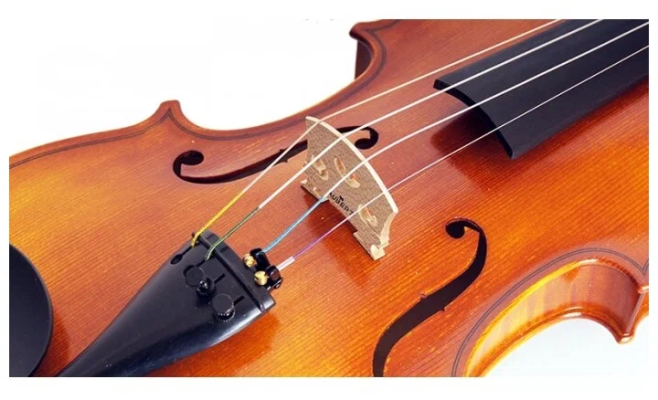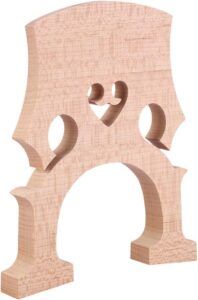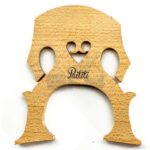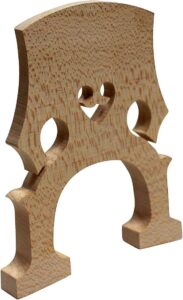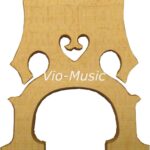Each part of the cello is important and different, but we will focus on one: the cello bridge. The job of the bridge is to act as a barrier between other parts of the instrument from sticking together and keeping them in tune. Cello bridges are important for holding the cello strings, and also serve as an essential means of transmitting vibrational energy from the strings to the soundboard. A cellist needs to look out for these, as they play a vital role in creating excellent sounds.
When it comes to buying cello bridges, there are many options available to you. You might find this overwhelming because each bridge has its own unique qualities. One easy way to find the best cello bridges is to look for reviews – like the ones we offer here. Not only do we have dozens of different products featured, but we dive into all their details so that you can make a more informed decision!
Top Cello Bridges Review
1. SKY New Cello Bridge
There are a lot of options out there to pick from, but another possibility would be the SKY New Cello Bridge.
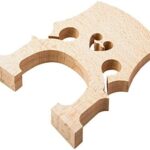
2. Fafeims Cello Bridge
The Fafeims Cello Bridge is made of high-quality maple wood. The wood material makes for good sound transmission, ensuring excellent sound quality for cello playing performance.
This cello bridge is anti-rust, eco-friendly, study and odorless – perfect for the active musician. It’s easy to set up and it’s not too big so it doesn’t take up a lot space. Plus, you can easily bring it anywhere!
3. SKY Fitted Cello Maple Bridge
We’ll start our list of the best cello bridges with the SKY Fitted Cello Maple Bridge for 4/4 full-size cellos.
It’s designed and fitted specifically for that type of instrument. This is a high quality maple bridge that is durable. It fits most cellos and makes it so you can play without any problems.
4. YMC Cello Bridge
The YMC Cello Bridge, on the other hand, is designed for a full-sized 4/4 cello. It’s made with aged maple wood and laser cut in order to create an accurate fit.
The shape of the ligature is easy to adjust and it can be fitted on both violins and cellos. The low cost combined with high quality make this purchase something you should definitely not overlook!
5. JTeller 1077KF Cello Fitted Bridge
The JTeller bridge is made from select, aged European maple and has an eye-catching figure.
Some guitars sounds better when they’ve been played a lot, others sound better when they’re new.
6. PIXNOR Cello Bridge
The PIXNOR Cello Bridge is made of maple wood. When you want an instrument to produce a darker tone, this wood would be the one for you.
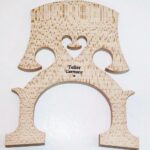
Analog, more advanced
7. JinQu Cello Bridge
JinQu Cello Bridges are made from quality maple and are made specifically for 4/4-sized cellos.
You can easily fit them on your strings and cello without any hassle. They’re also easy to modify to suit your needs.
8. Vio Music Cello Bridge
The Vio Music Cell Bridge is a good choice for 3/4 cello bridges.
It’s made of maple wood that can be customized to shape it and fit to the specifications of your cello. Laser cutting on the wood means it isn’t prone to cracking, unlike so many other bridges that are made from inferior quality timber.
9. Aubert 1051FM Bridge for Cello
On our short list is the aubert 1051FM Bridge for Cello. It is made with figured seasoned maple wood.
The cello bridge features a self-adjusting feet swivel that precisely fits into the contour of your cello top. It is ideal for 4/4 size instruments. You can use it for student and professional instruments or as an emergency.
10. Aubert VB-14 Old European Cello Bridge
The Aubert VB-14 is made out of the best-quality European maple that has been carefully dried and aged beforehand.
Cutting it can be hard to do! For the price you are getting a quality bridge that will last. It adds a bright and rich tone and makes your other strings sound better. This one isn’t slotted but is ready for final string setting.
What to Look for in Cello Bridges
Youre shopping for a cello bridge, make sure you take the time to find an item that has all of the features needed (e.g.: lightweight, durable). This way, nobody else can tell what type of strings you’re using. Similarly, you can learn what kind of bridge the cello has to see if it will last a long time. It’s high time to make your cello purchase, so it’s best that you found a company with a great reputation for making bridges.
Price
The price of cello matters a lot. A lot of bridges are relatively affordable, which means an average purchase price will allow you to get a high-quality musical instrument.
Material of Construction
When looking for a cello bow, different factors will affect your decision. A top quality bow is made with high-quality wood and this can impact durability as well as playability.
Shape
When you have a cello, even the bridge has to be shaped exactly. A deal-breaker for improperly shaped bridges is that they can’t properly fit on your instrument. So always make sure you stand firm on your decision to find a perfect one.
Size
Cello bridges come in different sizes. You’ll need to choose the one that will fit your instrument, so make sure to read our guide before ordering.
Curvature
One thing you should look out for is how curved your cello bridge is. You should make sure that the bridge isn’t flat, as curved bridges are typically stronger than flat ones. This is because the curved ones are able to provide structure and withstand the pressure from vibrations of the strings. Find that little dip in the front and it will have a relieved back.
Thickness
You should also consider the thickness of the cello bridge. A thicker bridge will produce a fuller sound. The thicker the cello bridge, the more difficult it is for vibrations to spread through. So sound coming from the cello would be softer and weaker.
You don’t even want a thin bridge, since it could break under the pressure that the strings would produce. It might sound bright, but it might not have the power to sustain when it’s up against the cello strings. So, if you’re looking for a bridge that’s the right thickness, try to pick one based on that.
Fit
You also need to make sure that the feet of the cello bridge would fit well with your instrument. The feet of the bridge are that part of it which touches the top of your cello. As much as possible, there should be no space between the cello’s feet and body. That way, you’ll get the maximum amount of energy without any people getting in the way. The space will only affect how sound travels though the bridge to the body.
Angle
We’ve covered some important features to take into account when purchasing new cello bridges. One point that might have been overlooked is the angle – it should be ninety degrees from the top of the instrument & just over seventy-five degrees from the back. The unstamped side of the bridge (the side facing you) should be tilted to around 90 degrees from the strings to the top of your cello when viewed from the left or right. When it lies at a different angle, you increase the risk of damaging it.
The cello bridges we just talked about are only a few of the many things you’ll want to look at while searching for the right one. You should keep in mind the features we have mentioned earlier to know the quality of a product before buying.
Conclusion
Whether practicing or performing, owning a top tier cello bridge is essential so as to improve your skills. If you are looking for the best cello bridges, they should come with the right features that will help your musician side – like correct curvature and thicknesses. Cello strings are not the only thing they do. In fact, they can also help you be a better musician in the long run.
FAQ for Best Cello Bridges
What are the best cello bridges?
Cellos are unique instruments that require special bridges to be attached. You can find a variety of cello bridges in the market and it is important to know what they are made of before you make a purchase decision.
Wooden bridges provide a warm tone while plastic ones provide a more crisp sound. Composite bridges combine both of these features and are good for playing in an orchestra setting.
To find the best cello bridge, you should consider the type of sound that you want, your budget, and your age level as well as your skill level.
What is the difference between a French, German, and American bridge for cello?
The bridge is the part of the cello that supports the strings and transmits their vibrations to the soundboard. There are different types of bridges for each country’s traditional cello.
The French bridge is very high and has a strong curve at its end. The German bridge is lower and straighter. The American bridge has no curve at its end but it is higher than the French or German bridges.
What are some of the different materials used in cello bridges?
Cellos are string instruments that are played by bowing the strings. They have a hollow body and a curved neck. There is a wide range of materials that can be used in the construction of a cello bridge.
Wood is one of the most popular materials used for bridge construction because it is easy to work with and relatively inexpensive. However, it does not produce as clear of sound as other materials such as carbon fiber or titanium.
Some bridges use ivory from elephant tusks because it produces a very clear sound, but this material has been banned from international trade since 1989 due to its extinction risk to elephants. Other popular materials include ebony, rosewood, maple, and spruce wood.
How can I tell if my bridge for cello is cracked or warped?
Bridge for cello is an essential part of the instrument. It holds the strings in place and helps them to vibrate. If it is warped or cracked, it can cause a lot of problems for your instrument.
There are a few things that you can do to tell if your bridge is cracked or warped:
- Check the bridge’s surface with your fingers. If you can feel any roughness, then there might be a crack in it.
- Put some pressure on the bridge while you are playing. If it starts to bend, then this means that there might be a crack in it.
- Take off the strings and look at the top of the bridge with a magnifying glass or microscope to see if there is any damage on its surface.
- Use an electronic tuner to check whether your instrument is out of tune when you play on different positions of the neck.
How often should I change my bridge for cello?
The cello bridge is a special device that is located between two “f-holes” and holds the strings in place. If you are playing your cello for long periods of time, it is likely that your bridge will wear down over time. It is important to know when to change your bridge, so you can avoid damaging it.
Changing your bridge depends on how much you play and what type of material it is made out of. The most common materials are maple, ebony, and rosewood. Maple bridges wear down quickly because they are softer than other types of wood.
Ebony bridges last longer because they are harder than maple bridges but not as hard as rosewood bridges. Rosewood bridges last the longest because they are the hardest type of wood used for cello bridges.
How can I tell if my bridge for cello is fitted properly?
The first thing you should do is to check the height of the bridge. The height of the bridge should be about 3/4″ (1.9cm) from the surface of the fingerboard. If it’s too high, you can use a shim to lower it down and if it’s too low, you can use a shim to raise it up.
The second thing you should do is to check whether or not there are any gaps between the strings and the fingerboard. The gap between strings and fingerboard should be about 1/8″ (3 mm). If there are any craps, then you need to adjust your bridge until they disappear.
The third thing you should do is to check whether or not there are any gaps between strings and sound post on top of your cello’s body near where your fingers go when playing.
What are some of the benefits of using a bone bridge for cello versus a plastic one?
A bone bridge for cello is a natural material that has been used for centuries.
Bone is a durable material that can withstand the natural wear and tear of playing an instrument.
It also provides the best sound quality compared to other materials such as plastic.
Bone bridges are also very light and easy to use, which makes them perfect for beginners.
What is the best type of bridge for cello to use?
The cello bridge is a small special part that is located between the strings of the cello and the body of the instrument. The bridge supports strings that are under tension due to the fact that they are stretched between the shank and the pegs at both ends. The bridge also transmits this voltage to the sound rack, which transmits it to the back of the instrument, creating a standing wave that resonates in response to the taut string.
The two most common types of cello bridges are fixed bridges and adjustable bridges. Fixed bridges have a single height, while adjustable bridges have multiple heights that can be changed by moving them up or down on their racks.
Fixed bridges are more stable than adjustable ones because they don’t move when you change position on a chair or bench during a game. Height-adjustable bridges allow you to find your own position to play and adjust the height of your hand, as well as how close you sit to the instrument.
How much do cello bridges cost?
The cost of a cello bridge can depend on many factors, such as the type of material used to make it, where it was purchased, how much it weighs and the design.
The average cost of a bridge for a cello is $25-40, but they can range from $10 to $80.
